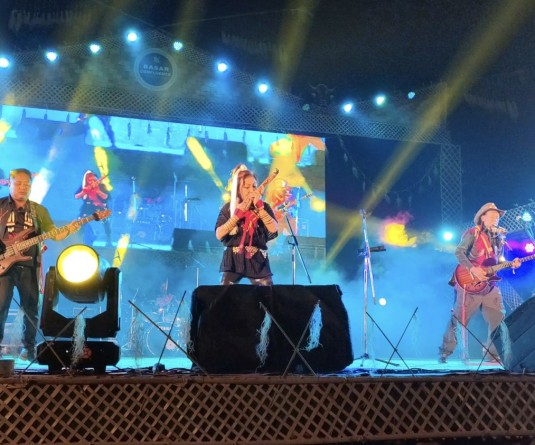
“Beyond its traditional role of entertainment or emotional expression, music can become a deeper vessel for connection, healing, and collective transformation”
Akangjungla
Dimapur | November 22
Charting another scale upward as a professional singer-songwriter, KL Pamei has enriched the music scene with the release of his debut album titled ‘Thuanku The.’ This young artist from Dimapur, Nagaland, not just carries a charm with humility but also creates original songs in his distinctive style, gaining him acclaims, accreting a large following on platforms like YouTube and other social media.
‘Thuanku The’, out on November 22 comprises 10 original songs, including the popular hits like Better Man and Khoya Khoya. The album took two years to attain its present form. His captivating voice and the originality in this album break barriers and resound with listeners from all background.
Read our conversation with the artist himself that covers the process in creating the album and his vision of music beyond the current form that coloured ‘Thuanku The’.
For KL Pamei, the title ‘Thuanku The’ which means ‘Thank You’ in Ronglat (Rongmei language), holds deep personal significance. “First and foremost, it reflects my roots and the pride I have in my ethnicity,” he said. It also serves as a heartfelt expression of gratitude to everyone who has helped make this dream a reality. “Beyond being the album title, the song ‘Thuanku The’ is dedicated to all of my supporters and well-wishers, whose encouragement and belief in me have been invaluable,” he said.
Revealing the “most original about his music,” Pamei said that the aspect lies in its fusion of cultural influences and personal experiences. “The process felt incredibly natural, especially with nearly every song. There was a smooth flow of creativity, and it just felt like the right pieces were coming together at the right time,” he shared.
Dream, passion and compassion
Dream, passion and compassion—these are the driving forces behind this album, he maintained. “At the outset, it felt like an impossible dream. I didn’t have the funds to even start, which led me to take out loans to make it happen. But every challenge was worth it because of the passion I had for this project.” He added, “As it began to take shape that passion evolved into compassion—a deep love for what it has become today.”

A journey of self-discovery and growth
The artist describes his creative process for this album as a journey of self-discovery and growth. He said that the process begun by reflecting on his experiences and emotions, allowing those elements to shape the themes of the album. “The process was both organic and intuitive. I would often start with a feeling, a melody, or a rhythm that felt right, and let it evolve naturally,” he revealed.
Throughout the album, there was a constant push-pull between passion and practicality. “I didn’t have all the resources from the beginning, but my determination and belief in the project kept me going.
The process felt very personal, but I also made space for collaboration, working with other musicians and producers who helped elevate the sound. In the end, every song feels like it fell into place naturally, as if it was always meant to be,” he said.
It took about two years to complete this album, and the reason for that is we dedicated ourselves fully to each song, Pamie said.
“We wanted to give 100% to every track, ensuring that none of them were neglected. During the process, we even scrapped some songs and replaced them with new ones that felt more aligned with the vision,” the artist mentioned. “You will notice that a few of the tracks stand out with a slightly different sound - these are the newer additions that incorporate more of a pop vibe, which is the direction I am moving toward as I evolve musically,” he added.
Art - a purpose in its own right
In his description about his approach to art and being an artist, Pamei said, “For me, art is more than just a means of expression—it’s a purpose in its own right.”
“As an artist,” he said, “I see it as a way to connect with others, to share my story, and to give voice to emotions and experiences that resonate on a deeper level.”
He also noted that he does not see art as something separate from life; it is a reflection of it—fluid, evolving, and personal. Being an artist is about being vulnerable and open to both the struggles and the beauty that come with the creative process. It is not about perfection, but about telling a story that’s meaningful and real, he articulated.
Playing live and doing music in studio
Pamei remarked that playing live and writing music in the studio is two distinct yet deeply connected parts of his creative journey. Each experience informs and enhances the other in unique ways.
In the studio, writing and recording music is a process of refining ideas. The artist explained that doing music in studio is introspective and focused. It is where he gets to shape his sound and experiment with different elements until he finds something that feels right.
“This environment allows for precision and control, enabling me to translate the vision in my head into something tangible. It is where I really dive into the technical side of music, where the composition takes form and the layers of emotion and sound come together,” he said.
However, performing live brings a different energy to the artist. “It is an exchange—between me and the audience, between the music and the people experiencing it,” he described. The raw emotion, the interaction with the crowd, and the freedom to improvise and play off the moment make live shows a unique experience. “Every time I step on stage, I am able to feel the music in a new way and connect with my audience in real time,” he expressed.

“Improvisation, which I often incorporate into live performances, is a natural extension of the work I do in the studio. It is a way of responding to the energy of the moment and pushing the boundaries of what’s on the record,” Pamei added. “In the studio, I compose with intention, but when I am on stage, I open myself up to improvisation, allowing the music to take on new shapes and meanings depending on the atmosphere,” he added.
A vision of music beyond its current form
“For me, music is a universal language, but I believe it has the potential to transcend even that limitation,” Pamei asserted.
He believes that beyond its traditional role of entertainment or emotional expression, music can become a deeper vessel for connection, healing, and collective transformation. Music, in its most organic form, can be a medium that transcends physical borders—where genres merge, and languages become secondary to the emotions they convey.
“Music will continue to evolve, embracing new technologies, yet it will remain grounded in its emotional power to tell stories, share experiences, and build community,” he reiterated.
‘Thuanku The’
The album ‘Thuanku The’ consists of 10 tracks, now available on all major digital platforms. Each song represents a unique aspect of my journey and musical expression.
The tracklist includes: Letting Go; Better Man; Dance; Yaara; Khoya Khoya; Love Someone; Keep in Me (featuring Koko Savino); It’s Okay; To Hold; and Thuanku The.
“I want to give a huge shout-out to my music producer, Kevi Pucho, Proprietor of Element Indie Studio, who worked tirelessly to bring these songs to life. From producing the tracks to mixing and mastering, Kevi’s energy and dedication were key in shaping the sound of the album. This project would not have been possible without the incredible musicians who contributed to the creative process. A big thank you to Augustine Eliem, Akok Imsong, Kora Sair, Merang Yanger, Wangshi, Alino Imsong, and Abdon for their amazing talent and hard work. This collective effort truly made “Thuanku The” come to life, and I am deeply thankful to each individual who has been part of this incredible journey.” – KL Pamei






